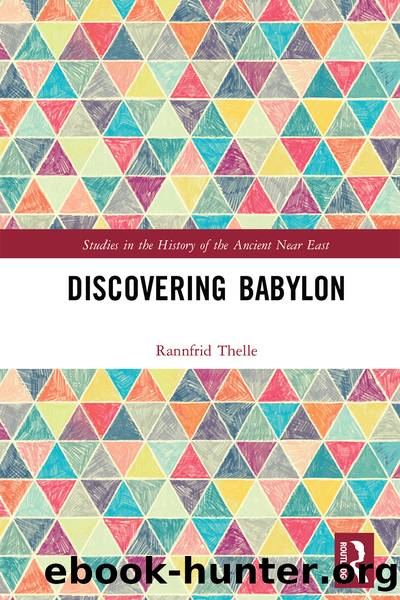Discovering Babylon by Thelle Rannfrid;

Author:Thelle, Rannfrid;
Language: eng
Format: epub
Publisher: Taylor & Francis Group
Published: 2020-10-15T00:00:00+00:00
Figure 6.1 The Babyloniansâ own map of Babylon, showing Babylon at the center of the world.
Up to around 1800 BCE, Babylon was a minor provincial town with rulers who went by the title ensi, a governor of sorts.11 Two political systems served as ideal models for Babylon, the Akkadian Kingdom (2340â2193 BCE) and the Third Dynasty of Ur (or Ur III), also referred to as the Neo-Sumerian Dynasty (2112â2004 BCE). The Akkadian Kingdom was the result of the conquest of the city-states, the first time they were all under centralized rule. The Akkadians were ethnic Semites who ruled from the city of Akkad, a city that is yet to be localized or identified with any particular ruin. The most famous Akkadian kings were Sargon and his grandchild, Naram-Sin. Sargon succeeded in gaining power over the city-states and replaced the governors (ensi) with Akkadian leaders who were loyal to him, calling himself âKing of Akkadâ. Later, after the southern Sumerian city-states also came under his realm of power, Sargon took the title âKing of the landâ. Sargon served as the royal ideal for kings of several later dynasties, including Hammurabi. Naram-Sin gained power over even more territory and gave himself the title âKing of the four corners of the worldâ. With Naram-Sin, a royal ideology developed that considered the king divine. The successors to Naram-Sin were not able to sustain their power, however, and successive invasions caused Akkad to deteriorate.
The next important consolidation of southern Mesopotamia under centralized rule occurred during what is often referred to as the Sumerian Renaissance, powered by the Third Dynasty of Ur. Thanks to the extensive textual remains found at Lagash and Nippur in the 1890s, and at Ur in the 1930s, we have detailed knowledge about specific phases of this history. Many clay tablets give ample insight into a thriving centralized state, with trade connections as far east as the Indus Valley. Ur-Nammu, the founder of Ur III, re-consolidated southern Mesopotamia into a centrally ruled territorial state and called himself âKing of Sumer and Akkadâ. He conducted extensive infrastructure and building projects, and was said to have built the ziggurat at Ur. His son, King Shulgi, the most important king in this Ur-dynasty, is said to have established libraries in Nippur and Ur. With Shulgi, ancient Sumer experienced a cultural renaissance, a rejuvenation of literature and learning. Shulgi established key judicial institutions, and the earliest known legal code hails from this period.12 The Babylonians later looked back to Sumerian literature as the ideal which they sought to emulate in their own literary tradition, and took custodianship of the rich heritage from the Sumerians throughout succeeding Babylonian periods.
When Ur was finally destroyed by invading Elamites, the devastation was so massive that a new literary form resulted: the city lament. The genre of âlament for a destroyed cityâ continued to survive as a mode of expression for centuries. The biblical book of Lamentations, which gives expression to the mourning over the destruction of Jerusalem, has some traits in common with this genre of city laments.
Download
This site does not store any files on its server. We only index and link to content provided by other sites. Please contact the content providers to delete copyright contents if any and email us, we'll remove relevant links or contents immediately.
| Africa | Americas |
| Arctic & Antarctica | Asia |
| Australia & Oceania | Europe |
| Middle East | Russia |
| United States | World |
| Ancient Civilizations | Military |
| Historical Study & Educational Resources |
The Daily Stoic by Holiday Ryan & Hanselman Stephen(2709)
The Fate of Rome: Climate, Disease, and the End of an Empire (The Princeton History of the Ancient World) by Kyle Harper(2436)
People of the Earth: An Introduction to World Prehistory by Dr. Brian Fagan & Nadia Durrani(2346)
Ancient Worlds by Michael Scott(2104)
Babylon's Ark by Lawrence Anthony(2070)
Foreign Devils on the Silk Road: The Search for the Lost Treasures of Central Asia by Peter Hopkirk(2056)
India's Ancient Past by R.S. Sharma(1988)
MOSES THE EGYPTIAN by Jan Assmann(1973)
The Complete Dead Sea Scrolls in English (7th Edition) (Penguin Classics) by Geza Vermes(1842)
Lost Technologies of Ancient Egypt by Christopher Dunn(1798)
The Daily Stoic by Ryan Holiday & Stephen Hanselman(1770)
The Earth Chronicles Handbook by Zecharia Sitchin(1744)
24 Hours in Ancient Rome by Philip Matyszak(1678)
Alexander the Great by Philip Freeman(1650)
Aztec by Gary Jennings(1545)
The Nine Waves of Creation by Carl Johan Calleman(1520)
Curse Tablets and Binding Spells from the Ancient World by Gager John G.;(1510)
Before Atlantis by Frank Joseph(1484)
Earthmare: The Lost Book of Wars by Cergat(1469)
